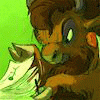
Once the largest carnivorous marsupial of both the Australian mainland, Tasmania, and New Guinea, the Thylacine was already declining when European settlers came to the shores of this far flung continent. As an apex predator, they were never particularly suited to the role. Despite initial assumptions, they did not posses a strong olfactory system as similar predators such as the wolf. They were not strong runners, but instead likely relied on surprise to hunt.
They had the ability to stand up for periods of time on its hind legs, similar to a kangaroo. Both male and females possessed pouches, a rare attribute in marsupials.
By the time they had become extinct on the mainland, due to a combination of the dingos partial domestication by aboriginal peoples who may have overrun the thylacine’s hunting ground as well as a decline in prey for any number of reasons, their isolation upon Tasmania spelt their doom. A bounty was put upon their heads by the colonial government due to their predation upon livestock. This bounty put pressure on an already declining species that led to substantial population loses.
The last known specimen died in captivity just 59 days after Tasmania declared them a protected species. Though people continued to report sightings of the creature through the 1960s, it was only listed as a endangered species through the 1980s despite little evidence of their continued existence.
Extinction Date According to the IUCN Red List: 1986
Category Artwork (Digital) / Animal related (non-anthro)
Species Unspecified / Any
Size 1000 x 696px
File Size 251.6 kB
Your anatomy studies are LEAPS and bound since the first time i saw you draw animals... and you know, it's something to be fiercely proud of. The addition of the local tribal ethnic art is such a lovely added decor, without going overboard. You control the balanced well.

 FA+
FA+








Comments